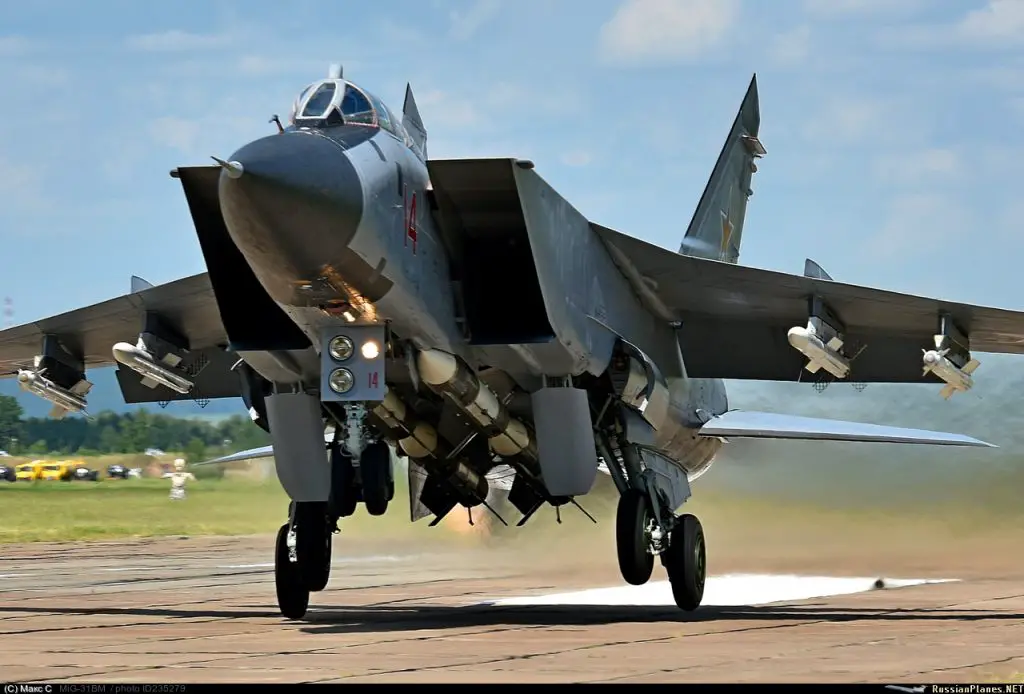This fall, according to available information, multipurpose MiG-31BSM aircraft participated in air combat for the first time in history. More than forty years after the first aircraft of this type entered service, this was a remarkable achievement for the Russian Air Force. Despite the fact that the first MiG-31s entered service in May 1981 and that their capabilities were considered to be among the best in the world, these aircraft did not participate in military conflicts until 2020, while the main forces of the Russian Aerospace Forces, including strategic intercontinental bombers, were engaged in anti-terrorist operations to eliminate Syrian militants.
The MiG-31K is a substantially upgraded derivative of the MiG-31D3 armed with hypersonic aeroballistic weaponry. This technology has the ability to strike targets over 2,000 kilometres from afar.
On March 18, 2022, the MiG-31K made its debut on the battlefield by launching a Kh-47M2 “Dagger” missile into an ammunition dump belonging to the Ukrainian army at Ivano-Frankivsk. This was the aircraft’s first action on the battlefield. As a result, the MiG-31BSM fighter-interceptor was the only aircraft currently in service with the Russian Air Force that had never taken part in an actual battle up until October of this year. This “combat debut” has been anticipated for a very long time since these aircraft are among the most powerful in the Russian fleet in terms of their ability to engage in aerial combat.
Project 518-22 (MiG-25), which began in 1971, was the foundation for the prototype of the MiG-31. This architecture features a fixed trapezoidal wing, a two-seat cockpit, a conformal suspension for long-range missiles, and a D-30-F36 turbofan power plant. In addition, the conformal suspension can accommodate long-range missiles. The MiG-25MP or Mig-31 aircraft is a development of the MiG-25 project; nonetheless, it is an entirely different aircraft in its essential design. It is better recognised around the world due to the visual similarities between the two aircraft.
The MiG-25 (Foxbat or “Flying Fox” according to NATO coding) is an aircraft of the third generation that was unprecedented at the time. It has consistently demonstrated its total impregnability to the most potent air defence systems of NATO nations in a variety of global zones.

In its final combat with the Western heavyweight, NATO’s premier Cold War fighter, the McDonnell-Douglas F-15, in February 1991 (Gulf War), an Iraqi-piloted MiG-25 gained an aerial victory and successfully completed its mission.
The MiG-31 Foxhound improved the MiG-25’s performance in a variety of ways, and some of the aircraft’s innovations are still unmatched. The MiG-31 has the largest radar station in the world, with no comparables. In addition, these gadgets introduced electronic phased array radars two decades before the rest of the world. Comparable technology was added to French and Japanese fighters in 2001 and 2002, respectively, and to U.S. Air Force fighters in 2005, while the Foxhound received it in 1981. In addition, this was the world’s first aircraft capable of sustained supersonic flight at Mach 2.3. This enabled it to respond quickly to attacks and maintain control over the vast Soviet Union area.
The indisputable advantage of the MiG-31 is the ability to carry an exceptionally high combat load, including six long-range R-37M missiles, as well as several classic variants of the R-33S or RVV-AE. The R-37M (610M) / RVV-BD missiles entered service in 2014 following the integration of modern avionics systems and Zaslon-M radar stations. They enabled fighters to destroy targets more than 400 kilometres away. Due to their great range and unmatched Mach 6 speed, these missiles ideally complement the capabilities of the MiG-31, which can launch them at a very high altitude and high speed, hence giving the R-37M significantly more energy than other Russian Aerospace Forces aircraft.
According to Russian media, the R-37M demonstrated a high level of effectiveness when coupled with the MiG-31 during combat operations over Ukraine. Recently, it was reported that these missiles have shot down multiple Su-25 attack aircraft and one Su-24 tactical bomber belonging to the Ukrainian Air Force. Approximately 110 MiG-31 aircraft are now deployed by the Aerospace Forces of the Russian Federation. All of the aircraft are modernised MiG-31BM/BSM models equipped with Zaslon-M radars.
Despite having far higher maintenance costs than the Su-35, the MiG-31’s combat capability is also exceptionally potent. Therefore, it is unlikely that these aircraft will be withdrawn until the new MiG-41 interceptor variant (PAK DP) is judged operational. In addition, a significant advantage of the MiG-31 is that its potential and technical capabilities are mostly unknown to NATO “partners,” as this is the only class of fighter that is not commercially available. Kazakhstan, Russia’s close security partner, is the only nation currently operating these aircraft; it inherited them following the fall of the USSR.
These aircraft were not inherited by the former Soviet nations in Europe that joined the Western community in 1991 and provided classified technology to NATO, notably Ukraine. All MiG-31s of the Air Defense Forces of the Republic of Kazakhstan were upgraded to the BM/BSM level, giving the country the most combat-ready fighter aircraft in Central Asia. In terms of their combat potential, the “thirty-first” is almost unique on a global scale. If the MiG-31 continues to demonstrate its supremacy in Ukrainian airspace, the number of MiG-31s in Russia’s military will surely increase.
Until the Su-57 becomes fully operational, the MiG-31 will remain the most effective Russian air-to-air aircraft.

I’m going to have to call b.s. on this story. Could not find any mention of MIG31 winning battle with a F15. None. Some Israeli F15s unverified in the 80’s that’s about it.
I think that is lack of continuity in the writing, they do operate in Irak, but both never engaged, F15 has never been lost in combat, however what is true is that a MiG-25 shoot down an F-18. You can check the story